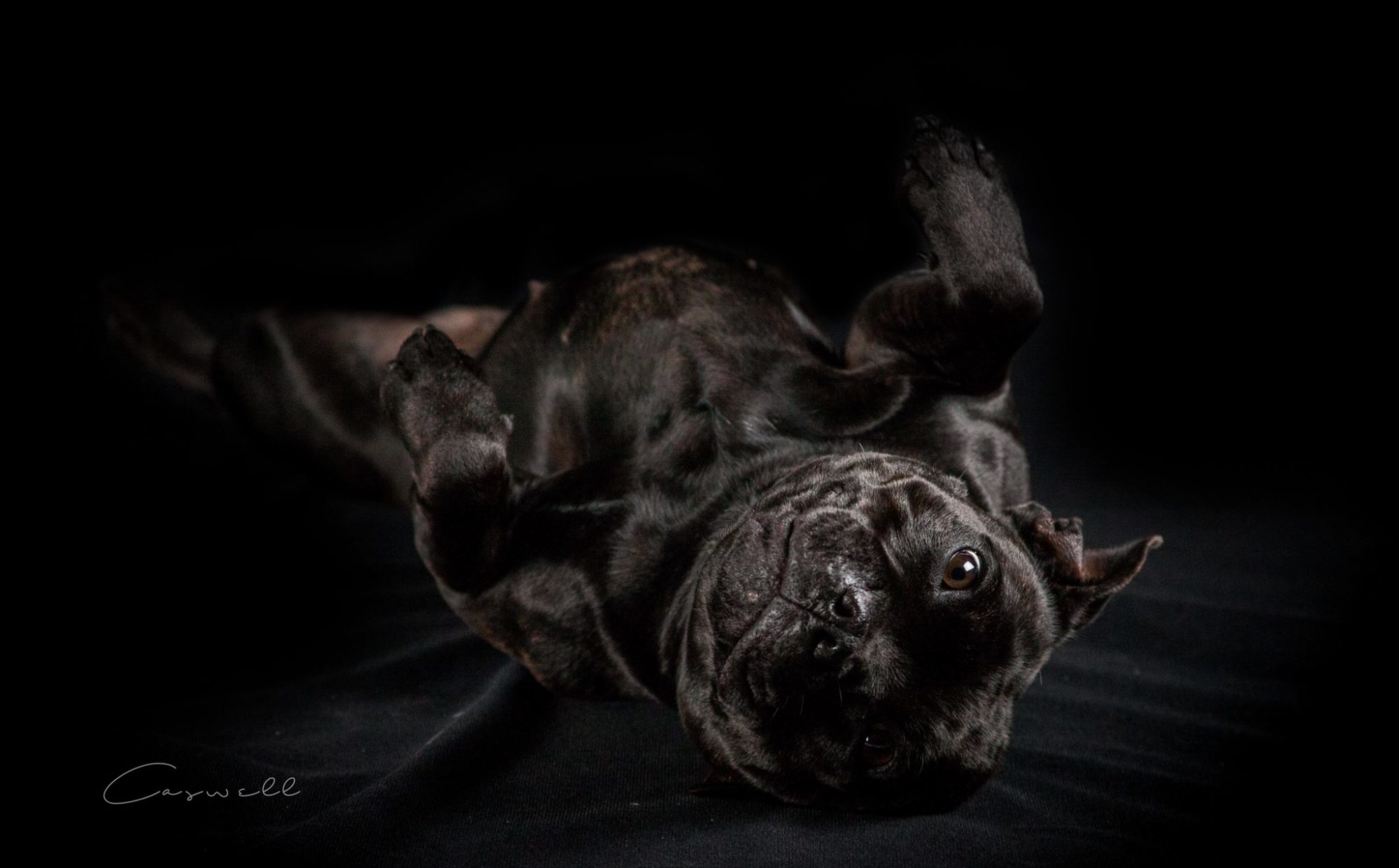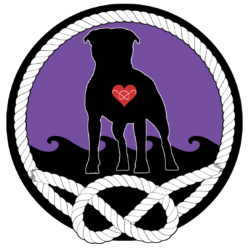First let me state that we are not geneticists so in order to write this bit we have consulted a couple of Stafford folks who happen to also be experts in the field of genetics. The following information is what we gleaned from them. Thank you to Norman Berry (Rendorn) and Sian Hammond (Hammystaff) for your interpretations.
(NOTE*** ONLY in America is B&T and Liver a DQ – in ALL other countries they are simply HIGHLY UNDESIRABLE)
The colors allowable section seems quite straight forward except when you get into the colors considered to be a disqualification there is some confusion. Since ‘Black and Tan” actually refers to a genetic pattern, and not a coat color, it can be confusing. The dogs coat can indeed appear to be a black brindle with tan points (above eyes, cheeks, feet and lower legs, rear end, etc such as on a Rottweiler) but can also appear as black brindle with brindle points, red with fawn points, blue with fawn points, pied with tan points, tri-color – black brindle with white markings and tan points and any number of combinations such as these – if the dog has points it has the genetic marker called ‘Black and Tan” and should be disqualified according to the written breed standard. They should be identified based upon their markings, rather than their colorings.
Recessive genes are very unpredictable. The color of the parents is irrelevant, b&t or tri is not caused by the mixing of any two specific coat colors – which means both parents must pass the tan point gene on to that specific puppy. It’s got nothing to do with mating red to brindle – black and tan, or, black and tan with white is NOT caused by color genes. The color of the parents is irrelevant as the black and tan coat is caused by one of the genes which dictates the pattern that the colors appear in on the coat.
The brindle gene creates stripes, the tan point gene creates the pattern as seen in Dobes, Rotts, Manch Terriers and so on.
Therefore, you could mate any two colors together and get the tan point pattern, IF both of them carry a tan point pattern gene. Makes no difference what color they are as B & T is not a color, it is a pattern.
The parents colors, will only affect the colors that the pattern appears in. ie, if the parents pass on red with black (ie masking etc) then black and tan pups will appear in the standard Rottie type coat. If one of the parents also passes on a brindle pattern gene, then then tan points will be brindled, not just tan. A dog can be what is classed as black and tan, but its colors can be red and cream, blue and fawn whatever. If one of the parents also passes on a brindle pattern gene, then then tan points may be brindled not jut tan.
The gene will only affect WHERE the colors go, not what they are.
For a B & T with brindle covered points to occur the brindle would have to carry two copies for brindle. For it not to happen would be for the brindle to carry one copy of red and one copy of brindle.
More specifically, a brindle carrying red, mated it to a red as described above (who like any other red, cannot have any brindle in it’s make up what so ever), there is a possibility that a red puppy could be the result. If the brindle parent it is not carrying red then a brindle puppy will be the result.
Now back to the B & T and summarize: should the above parents carry B+T the same formula will apply.
Red /red + B & T will guarantee a true B & T like the Doberman. A brindle/red + B & T MAY be like a Doberman, or, MAY have brindling covering tan points. A brindle to brindle will guarantee brindling covered tan points.
The argument made is that when the standard was written they didnt know about genetic markers so some take the term ‘Black and Tan’ literally and do not include the other variations in disqualification. That would be incorrect genetically, however.
*Interesting fact – there is no such thing, genetically speaking, as a black Stafford. All black looking Staffords are considered to be black brindle.
Liver is also to be disqualified. Again, genetically speaking the term liver refers to a dilute, not simply the actual color of a liver. Check for a black nose. If the nose (foot pads also) appears brown or red the dog is more than likely a liver, a dilute.
The confusion begins when you look at a blue Stafford. Since blue is also a dilute it would be impossible for a blue Stafford to have a true black nose no matter how dark it appears – however – blue is an allowable color according to the Breed Standard. The founding fathers of this breed certainly had no intentions of a dog that was blue to start off with a disqualifying fault – to them – the nose appeared black and that was good enough. A Blue should have good pigment, just like other colors, but it will not be a true black – it shouldn’t appear washed out, however.
It does keep you on your toes, doesn’t it?! We produced a Blue and a Blue Brindle mating a Brindle to a Black Brindle – both carried the dilute gene even though we had not seen evidence of this behind the dam for 9 generations. It is best not to mate Blue to Blue. Blues produced from dark pigmented Brindle or Black Brindle should keep the dark pigment. The offspring should be mated back to Black Brindle or Brindle that doesn’t carry the dilute gene or not mated at all. To breed for color and not for virtue will only weaken your qualities in other areas. The same is true for breeding any like colors continuously but especially dilutes.
Blues, fawns and blue brindles arise from the action of the ‘d’ gene on the colors red, black brindle and brindle.
There are now DNA marker tests available to determine whether or not your Stafford carries the dilute gene responsible fro producing blue – also available is a test for Black & Tan patterning. Several labs around the world offer both a test for Dilute (d) and also B&T (at).
As things currently stand, there is a great divide on the interpretation of the AKC breed standard where B&T is understood. What are your thoughts on this topic and how would you clarify this portion in order to be as clear as possible to protect and preserve this breed?
*Note – The UK version of the Staffordshire Bull Terrier Breed Standard states that Black & Tan and Liver are ‘highly undesirable’ but the AKC version states they are to be disqualified.
Red, fawn, white, black or blue, or any of these colors with white. Any shade of brindle or any shade of brindle with white.
Black-and-tan or liver color to be disqualified.









